|
Lancia revives
the custom of holding the world previews of its new products
in Geneva. After the Thesis in 2001, the Phedra in 2002, the
Ypsilon in 2003 and the Musa in 2004, today it is the turn
of the Ypsilon Sport, a concept car developed jointly with
Zagato, the famous Milan Style Centre, that has 'dressed'
numerous Lancias in the past.
An expression of power and sportiness, the new car marks
Lancia's return to a field in which it has always been a
leading player, writing important pages of motoring history.
This is why the stand for the Geneva Motor Show returns to
the themes of sportiness and technology, which it interprets
alongside the concepts of Italian elegance and hospitality:
the distinguishing features that have always been part of
the Lancia heritage. As a result, we can divide the Lancia
stand into two different areas: on one side, the world of
the two-tone cars that epitomise the brand's traditional
elegance; and on the other the technical excellence and
performance represented by the current range and by the
Ypsilon Sport.
In both areas, refined, stylish materials, such as walnut
wood, marble and Wenghe wood, convey an elegant,
sophisticated luxury that is never overstated. The whole
setting is made more 'technological' and projected into the
future by two large LED screens which cover part of the
Lancia building.
The new structure is built on two levels, both of which are
visible because the cube that extends over the stand is
transparent: on the ground floor is the Lancia boutique,
which has been left visible from outside so as to capture
people's attention with items of pure Italian class, and the
Water Bar where visitors can quench their thirst, choosing
from a range of over fifty types of bottled water. The
stairs give access to a private upper area which offers a
view of the stand and particularly of the car designed by
Zagato.
The Ypsilon Sport prototype is the centre of attraction of
the display; it stands on a circular glass and metal
pedestal, an object of great visual impact that exudes
technology. The two themes expressed in the display area are
in fact 'sportiness' and 'technology', embodied in the glass
case containing the 70 bhp 1.3 Multijet engine, a true
revolution in the engine world. Four cars, representing the
entire Lancia range, are displayed on the marble floor: they
all have black paintwork, a sporty but elegant colour that
sets off the original 'livery' of the Ypsilon Sport.
First of all, the Lancia
Musa, the model that communicates the concept of
'Italian hospitality', where we are guests and not
passengers. The version presented in Geneva sports the
Platino outfit and is equipped with the sparkling 95 bhp 1.4
16v engine and the 'Dolce Far Niente' robotised
transmission; it invites us to share the pleasure of
travelling in a car that is unique in its segment. It is
certainly a luxury product, but it never overdoes things
because it was designed to reflect the wishes of people who
like to enjoy life without forgoing practicalities. The
Lancia Musa introduces the secrets of Italian hospitality to
the car world; it is a car that welcomes its guests with
good taste, warmth and generosity.
The Lancia Musa conveys good taste in its refined,
harmonious lines, elegantly matching warm colours, precious
details (like the grille and two-tone wheel rims), and
quality materials (leather combined with microfibre). Its
size is just as suitable around town or on long journeys:
3.98 metres long, 1.70 metres wide and 1.66 metres high,
setting new standards in this particular compact car
bracket.
The Lancia Musa conveys warmth in the sensations it offers
its guests: the luminosity of the 'GranLuce' sunroof and the
airy interior, the pleasant surfaces and the enveloping
comfort of the ergonomic seats. The dual zone climate system
and Bose Sound System (typical equipment on a Lancia) make
the interior space particularly enjoyable, and one that you
dominate better thanks to the raised driving position, the
ergonomic controls and the versatile seats, which can be
moved into 32 different positions (including an unusual
'chaise longue' configuration).
The Lancia Musa conveys generosity with its technological
features: engines that guarantee excellent performance, for
relaxed, carefree driving. Two Multijet diesel units: the
100 bhp 1.9 which is round and elastic, ideal in any
situation and the 70 bhp 1.3, which is perfect for the town,
combined with the 'Dolce Far Niente' robotised sequential
transmission. Motorists who travel shorter distances will
enjoy the sparkling 95 bhp 1.4 Fire engine. We find the same
generosity in the vast, comprehensive array of standard
equipment (the Platino outfit includes the 'GranLuce'
sunroof, leather and microfibre upholstery, radio-CD player
and alloys) and in the 'Parure Lancia' Warranty, the
exclusive package that extends the contract warranty up to
five years from registration or to a maximum of 120,000 km.
Travelling in the Lancia Musa is a warm, reassuring,
enjoyable experience, which underlines the pleasure of a
life made of good taste and well-being. And the name Musa
reflects this concept: a classical name that evokes art and
creativity. Even the graphical elements have a strong link
with the car: the design of the letter 'M' recalls a chaise
longue, a symbol of comfort and relaxation.
Next to the Musa we find the other star of the stand, the
Lancia Ypsilon,
exhibited in its more lavish specification (Platino) and
powered by the brilliant 95 bhp 1.4 Fire engine. After a
year of success with the public and the critics - during
which it has been awarded the 'European Automotive Design
Award' in Brussels, the 'Car I prefer in 2004' title by the
readers of Quattroruote and that of the 'Most beautiful car
in the world' by a jury of design experts - the Lancia
Ypsilon confirms that it is the ideal car for a
sophisticated clientele, always looking for unique products.
This clientele is immediately attracted to the model by its
original styling which is perfectly in line with those
modern design trends that favour a softer, more sensual
line. The interior greets passengers and driver in a
welcoming environment, but the passenger compartment is also
functional and modern, guaranteeing the utmost comfort at
all times.
Sensations that are enhanced by the great care that goes
into every detail, the luxurious materials used, worthy of a
luxury car, and the refined, elegant colour combinations
between the shades of the bodywork and the upholstery.
Unique features for a car from this segment. Even the 'Ypsilon'
logo is a designer signature.
From the styling to the mechanicals. The Lancia Ypsilon
proposes the best that modern engineering can offer where
engines and transmissions are concerned. Of course, the
model's great on-road characteristics, its predictable
behaviour and easy, enjoyable driving are also due to the
performance of a 'power pack' that is on the cutting edge
for a city car. There is a choice of four engines. The first
two are the tried and tested 60 bhp 1.2 and 80 bhp 1.2 16v,
which deliver outstanding torque and smooth running in spite
of a relatively small size. The other two are: the brilliant
95 bhp 1.4 16v and the revolutionary 70 bhp 1.3 16v Multijet,
both of which can be combined with a manual gearbox or a
sequential robotised device known as the 'Dolce Far Niente'.
And finally, it is not exaggerated to say that everyone will
find the Lancia Ypsilon to meet his needs and tastes. The
new family comes in four different specifications (Ypsilon,
Argento, Oro and Platino) and it is one of the most
comprehensive in this segment. This is partly due to the
fact that there are no less than 555 ways of customising
this 'pocket flagship': by combining eleven body colours,
six different types of upholstery (in eight different
shades) and five types of alloy wheels (including those from
the Lineaccessori). Whatever your choice and the level of
customisation you prefer, the Lancia Ypsilon is always
fascinating and original, personifying Italian good taste
that is famous the world over.
The two Lancia flagships, the Phedra and the Thesis, could
not be absent from the Geneva stand, and they are both
exhibited in the most prestigious outfit (Emblema). A
Lancia Phedra 3.0 V6 24v
CAE, the expression of the Italian art of living,
is exhibited in this same area of the stand. The model has a
hushed interior, which is pleasant to look at and to touch;
great care has gone into every detail and the effect is one
of an ambience designed for enjoyable social relations. It
is equipped with a range of safety, comfort and telematic
devices that place it at the top of its class.
From this year, two new bodywork colours are available:
exclusive Rossini Grey and Brunelleschi Pearl, a light pearl
that is nonetheless warm and sophisticated. Plenty of
comfort and stylistic refinement, obviously, but also
class-beating performance.
|
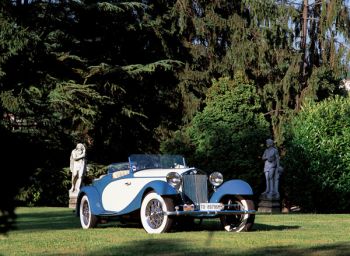 |
|
|
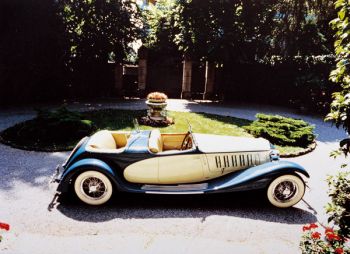 |
|
|
|
The first car visitors will see on the designated
'catwalk' section of the Lancia stand in Geneva will
be, sporting a two-tone 'livery' (ivory and blue),
is the elegant 1933 Lancia Astura Double
Phaeton 'Castagna', the only car in the
world to win the famous 'Villa d'Este Gold Cup'
twice: 1933 & 2004 |
|
|
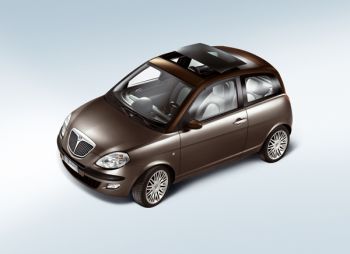 |
|
|
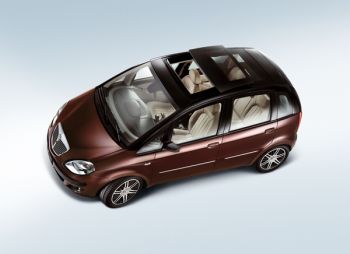 |
|
|
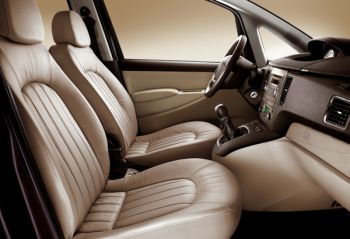 |
|
|
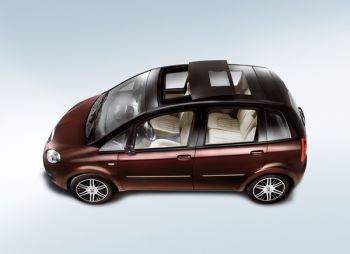 |
|
|
|
The new Lancia Ypsilon family (top) comes in four
different specifications (Ypsilon, Argento, Oro and
Platino), while its sister model, the Musa is show
in 2005 specification (above) |
|
|
Thanks to the four engines on offer: they start from the 136
bhp 2.0 16v petrol engine and the 108 bhp 2.0 JTD 16v, which
combine excellent performance and low running costs. The
other engines in the range are the 128 bhp 2.2 JTD 16v, a
particularly lively turbodiesel which guarantees
entertaining driving in all situations, and the superb
6-cylinder, 204 bhp 24v 3-litre engine, with a
self-adaptive, sequential automatic transmission. This unit
is capable of amazing performance, and a top speed of over
200 km/h, but with the quiet operation of a 6-cylinder
engine, smoothness and strong acceleration guaranteed by
generous torque, as well as outstanding comfort and
enjoyable driving.
Next to the Lancia Phedra, visitors can admire the
Thesis Emblema 3.2 24v V6
with 'Comfortronic' transmission, a great saloon
that focuses on elegance and cutting edge technology, to
appeal to the motoring elite. This is a particular segment
with a small number of models on which the most important
carmakers concentrate the best that automotive engineering
offers today. In addition to the 3.2 24v V6, another engine
was introduced in 2003, the 175 bhp 2.4 JTD 20v, which is
one of the second generation of common rail direct injection
diesels, the Multijet engines, and it is available with a
five-speed automatic transmission or a manual six-speed
gearbox. Two powerful, smooth engines for which the
sophisticated five-speed automatic transmission was
recalibrated, to guarantee 'smoother' gear changes and a
significant increase in driving comfort. And finally a 40.7
kgm six-speed mechanical gearbox replaces the present
gearbox, being better suited to the higher torque delivered
by the 2.4 JTD 20v. This unit is more compact and has three
axes, a synchronised reverse, and a clutch with automatic
wear adjustment.
These are the novelties in the range. However, all the
strong points of the Lancia flagship remain firmly in place:
the lavish array of standard safety equipment, the luxurious
interior, which is spacious and protective, the
sophisticated CONNECT info-telematic system and the seats
which represent the state of the art where comfort and
ergonomics are concerned. On the optional 'comfort' version
the seats are fitted with soft nappa leather upholstery by
Poltrona Frau.
The second area of the Geneva stand is dedicated to the
two-tone world. The first car visitors see on the catwalk,
sporting a two-tone 'livery' (ivory and blue) is an elegant
1933 Lancia Astura Double
Phaeton 'Castagna', the only car in the world to
win the famous 'Villa d'Este Gold Cup' twice, in 1933 and
2004. The 75th edition of the beauty contest for car design,
held at Villa d'Este (Cernobbio) paid homage to one of the
most fascinating cars of international motoring history.
Commissioned by an American customer from the Castagna
bodyworks - it is thought to have been a gift to her husband
from the famous tobacco heiress Barbara Hutton - the car was
based on the second Astura series, but because it was
delivered early in 1934, it already included the changes
introduced on the third series. The Lancia Astura Double
Phaeton 'Castagna' was in Washington D.C. during the Second
World War, and it remained in the United States until 1983,
when it returned to Italy.
In 1996 the car was purchased by Guido Lamperti, a member of
the Italian Historical Lancia Club and curator of the
Historical Register.
We remind you that the splendid car on show in Geneva was
derived from the Astura model (named after a castle near
Nettuno), of which four series and 2,911 cars were built
between 1931 and 1939. At its launch, the model was powered
by a narrow V-8 (19°) 2,604 cc engine that delivered 73 bhp
at 4000 rpm, and had a top speed of 125 km/h. In 1934, for
the third series, the engine size increased to 2,972 cc and
82 bhp, and two versions were available: the 233L, with a
long 3,332 mm wheelbase, and the 233C with a short wheelbase
of 3,100 mm. And because of its roadholding and handling,
the Astura was also used for motor racing: at the 1934 Giro
d'Italia it took the first two places overall. The chassis
was of the 'spider' type made of boxed sheet metal, onto
which the engine was attached elastically by two short leaf
springs: a Lancia patent which eliminated engine vibration
almost entirely. Stylistic elegance and mechanical
innovation were already embodied in the Lancia Astura Double
Phaeton 'Castagna', a combination that is shared by the many
'four-wheeled' works of art designed by Lancia.
(Vincenzo Lancia (1881-1937) will be remembered in
particular during the Geneva Motor Show this year because he
will join the pages of the European Automotive Hall of Fame,
with three other pioneer carmakers. It is a prestigious
register, created by the magazine Automotive News, which
includes the names of the most important and famous
businessmen, engineers and designers who have contributed to
the progress of the motor industry. A tangible sign of how
the founder's passion and skill are still admired in the
world today. Lancia is also exhibiting a unique version of
the Lancia Musa 'b-colore'
that reiterates this 'vintage' context.
Elegance, refinement and originality are the words that link
the harmony of forms with attention to detail, and this is
the inspiration behind this exclusive version of the Lancia
Musa. Compared to the standard production models, this
version has an additional touch of originality and class. An
extremely clean, harmonious line that is set off by the
two-tone bodywork: metallescent Tintoretto Bordeaux (one of
the loveliest colours in the range), combined with a shiny,
lacquered-effect black, and a diamond finish on the alloy
wheels. The interior is furnished with the same refinement
and exclusiveness that are synonymous with the best Lancia
tradition; a stylish lounge upholstered in hand-crafted
ivory leather on the seats and the door panels. And the
cushions and the central panel of the squab are decorated
with Bordeaux leather ribbons, a feature borrowed from the
furniture industry, with a 'wide rib' quilting effect, that
matches the exterior colour.
Beside this 'automotive jewel', Lancia proposes two
Lancia Ypsilon 'b-colore',
both in the Argento specification and equipped with the
'Dolce Far Niente' gearbox. The first, powered by the
brilliant 70 bhp 1.3 Multijet engine, has elegant,
sophisticated bodywork, with Paganini Ivory on the bottom
half and exclusive pearlescent Caravaggio Brown on the top.
A timeless combination, picked up delicately in the interior
which reiterates the colours of the bodywork. And the
upholstery on the second Ypsilon 'b-colore' 1.4 16v is just
as exclusive: this car is magnesium and brown, a combination
that blends perfectly with the exterior line, which is
highlighted by Rossini Grey at the bottom, with the new
Caravaggio Brown at the top. The end result is a new, strong
chromatic contrast that is simply irresistible.
|
|
|
|
![]()
![]()